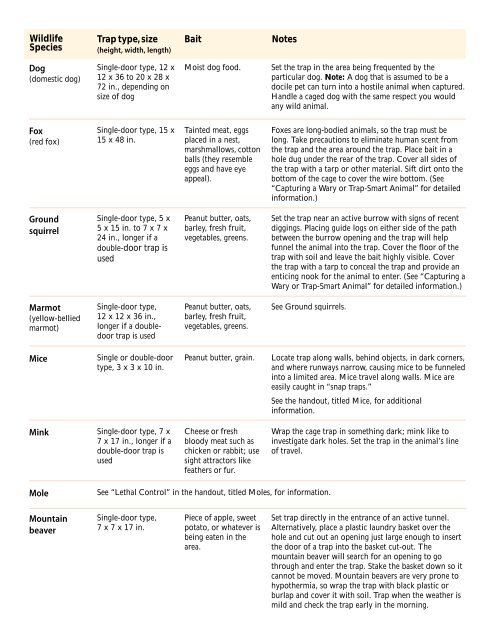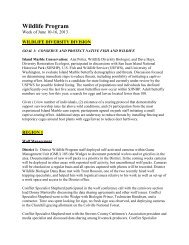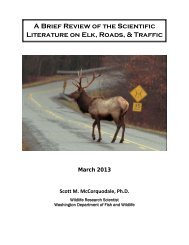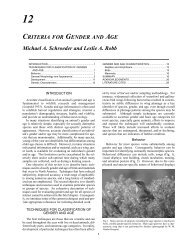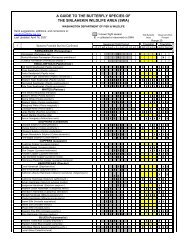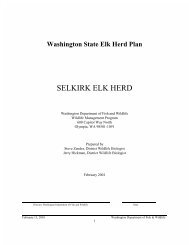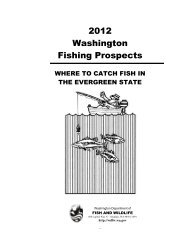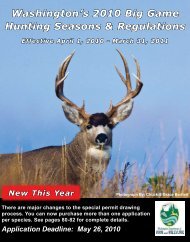Trapping Wildlife - Washington Department of Fish & Wildlife
Trapping Wildlife - Washington Department of Fish & Wildlife
Trapping Wildlife - Washington Department of Fish & Wildlife
Create successful ePaper yourself
Turn your PDF publications into a flip-book with our unique Google optimized e-Paper software.
<strong>Wildlife</strong><br />
Species<br />
Dog<br />
(domestic dog)<br />
Fox<br />
(red fox)<br />
Ground<br />
squirrel<br />
Marmot<br />
(yellow-bellied<br />
marmot)<br />
Mice<br />
Mink<br />
Mole<br />
Mountain<br />
beaver<br />
Trap type, size<br />
(height, width, length)<br />
Single-door type, 12 x<br />
12 x 36 to 20 x 28 x<br />
72 in., depending on<br />
size <strong>of</strong> dog<br />
Single-door type, 15 x<br />
15 x 48 in.<br />
Single-door type, 5 x<br />
5 x 15 in. to 7 x 7 x<br />
24 in., longer if a<br />
double-door trap is<br />
used<br />
Single-door type,<br />
12 x 12 x 36 in.,<br />
longer if a doubledoor<br />
trap is used<br />
Single or double-door<br />
type, 3 x 3 x 10 in.<br />
Single-door type, 7 x<br />
7 x 17 in., longer if a<br />
double-door trap is<br />
used<br />
Single-door type,<br />
7 x 7 x 17 in.<br />
Bait Notes<br />
Moist dog food. Set the trap in the area being frequented by the<br />
particular dog. Note: A dog that is assumed to be a<br />
docile pet can turn into a hostile animal when captured.<br />
Handle a caged dog with the same respect you would<br />
any wild animal.<br />
Tainted meat, eggs<br />
placed in a nest,<br />
marshmallows, cotton<br />
balls (they resemble<br />
eggs and have eye<br />
appeal).<br />
Peanut butter, oats,<br />
barley, fresh fruit,<br />
vegetables, greens.<br />
Peanut butter, oats,<br />
barley, fresh fruit,<br />
vegetables, greens.<br />
Foxes are long-bodied animals, so the trap must be<br />
long. Take precautions to eliminate human scent from<br />
the trap and the area around the trap. Place bait in a<br />
hole dug under the rear <strong>of</strong> the trap. Cover all sides <strong>of</strong><br />
the trap with a tarp or other material. Sift dirt onto the<br />
bottom <strong>of</strong> the cage to cover the wire bottom. (See<br />
“Capturing a Wary or Trap-Smart Animal” for detailed<br />
information.)<br />
Set the trap near an active burrow with signs <strong>of</strong> recent<br />
diggings. Placing guide logs on either side <strong>of</strong> the path<br />
between the burrow opening and the trap will help<br />
funnel the animal into the trap. Cover the floor <strong>of</strong> the<br />
trap with soil and leave the bait highly visible. Cover<br />
the trap with a tarp to conceal the trap and provide an<br />
enticing nook for the animal to enter. (See “Capturing a<br />
Wary or Trap-Smart Animal” for detailed information.)<br />
See Ground squirrels.<br />
Peanut butter, grain. Locate trap along walls, behind objects, in dark corners,<br />
and where runways narrow, causing mice to be funneled<br />
into a limited area. Mice travel along walls. Mice are<br />
easily caught in “snap traps.”<br />
See the handout, titled Mice, for additional<br />
information.<br />
Cheese or fresh<br />
bloody meat such as<br />
chicken or rabbit; use<br />
sight attractors like<br />
feathers or fur.<br />
See “Lethal Control” in the handout, titled Moles, for information.<br />
Piece <strong>of</strong> apple, sweet<br />
potato, or whatever is<br />
being eaten in the<br />
area.<br />
Wrap the cage trap in something dark; mink like to<br />
investigate dark holes. Set the trap in the animal’s line<br />
<strong>of</strong> travel.<br />
Set trap directly in the entrance <strong>of</strong> an active tunnel.<br />
Alternatively, place a plastic laundry basket over the<br />
hole and cut out an opening just large enough to insert<br />
the door <strong>of</strong> a trap into the basket cut-out. The<br />
mountain beaver will search for an opening to go<br />
through and enter the trap. Stake the basket down so it<br />
cannot be moved. Mountain beavers are very prone to<br />
hypothermia, so wrap the trap with black plastic or<br />
burlap and cover it with soil. Trap when the weather is<br />
mild and check the trap early in the morning.


